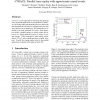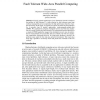FAST
2007
14 years 4 months ago
2007
//TRACE1 is a new approach for extracting and replaying traces of parallel applications to recreate their I/O behavior. Its tracing engine automatically discovers inter-node data ...
ARC
2010
Springer
14 years 6 months ago
2010
Springer
High-Performance Reconfigurable Computers (HPRCs) are parallel machines consisting of FPGAs and microprocessors, with the FPGAs used as co-processors. The execution of parallel app...
LCR
2000
Springer
14 years 6 months ago
2000
Springer
Abstract. We present a system that allows task parallel OpenMP programs to execute on a network of workstations (NOW) with a variable number of nodes. Such adaptivity, generally ca...
IPPS
2000
IEEE
14 years 6 months ago
2000
IEEE
Executing parallel applications across distributed networks introduces the problem of fault tolerance. A viable solution for fault tolerance must keep overhead manageable and not c...
DICS
2006
14 years 6 months ago
2006
Dynamic Parallel Schedules (DPS) is a flow graph based framework for developing parallel applications on clusters of workstations. The DPS flow graph execution model enables automa...
IPPS
1996
IEEE
14 years 7 months ago
1996
IEEE
Checkpointing of parallel applications can be used as the core technology to provide process migration. Both, checkpointing and migration, are an important issue for parallel appl...
COORDINATION
1997
Springer
14 years 7 months ago
1997
Springer
The aim of this paper is to promote the idea of developing reusable coordination patterns for parallel computing, i.e. customizable components from which parallel applications can ...
ICPP
1997
IEEE
14 years 7 months ago
1997
IEEE
Communication characterization of parallel applications is essential to understand the interplay between architectures and applications in determining the maximum achievable perfo...
HPDC
1997
IEEE
14 years 7 months ago
1997
IEEE
This paper presents a novel networking architecture designed for communication intensive parallel applications running on clusters of workstations (COWs) connected by highspeed ne...
HPDC
1997
IEEE
14 years 7 months ago
1997
IEEE
This paper describes PARDIS, a system containing explicit support for interoperability of PARallel DIStributed applications. PARDIS is based on the Common Object Request Broker Ar...


